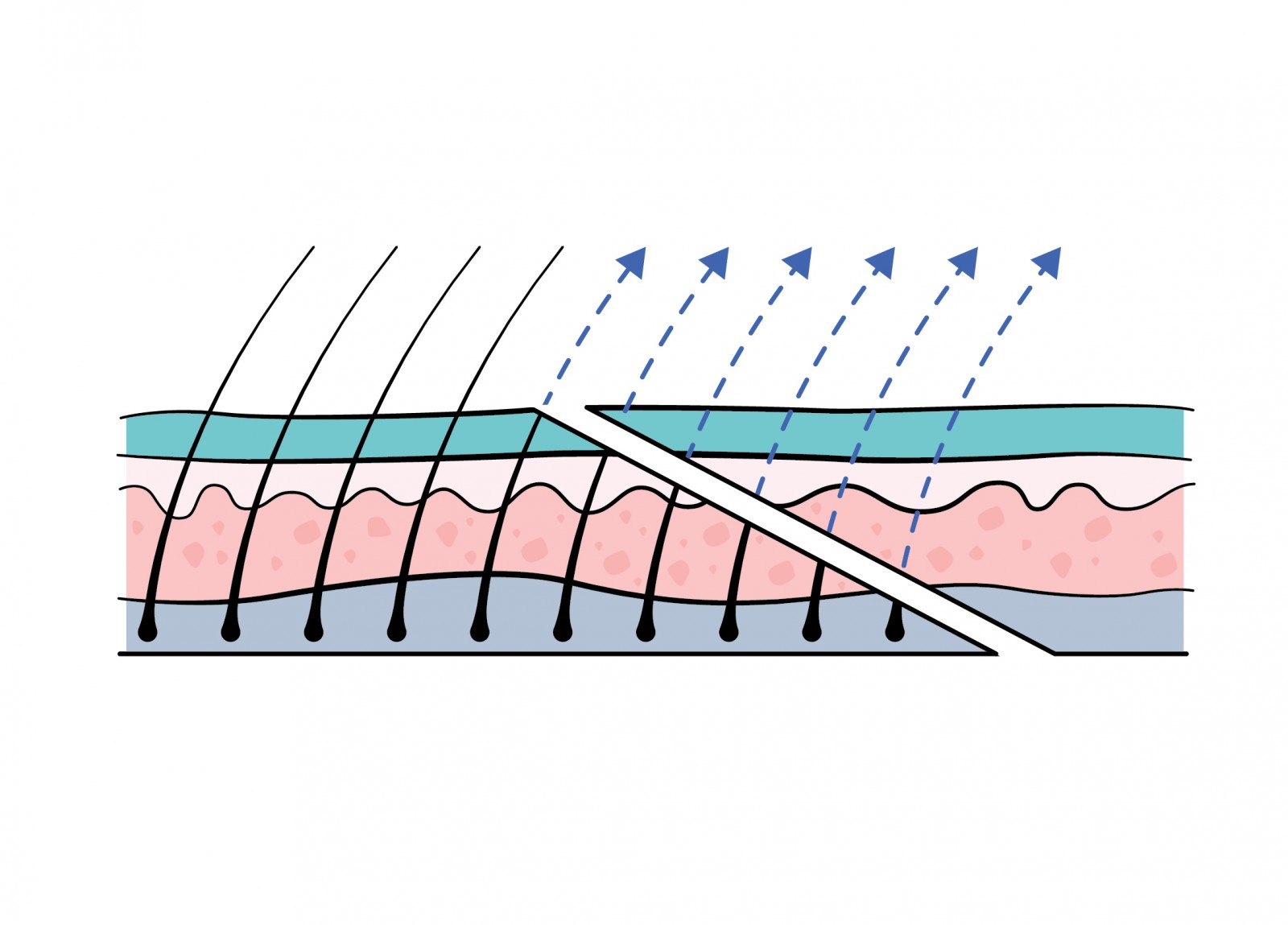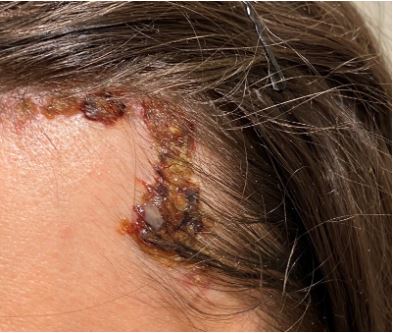Hairline lowering surgery
What is classic hairline lowering?
Hairline lowering (also called a scalp advancement or forehead reduction) is a surgical technique that allows patients to have their frontal hairline advanced certain distances depending on variables such as pre-operative hairline height, scalp laxity and patient preference. The alternative treatment would be hair transplantation.
 The angle of the incision is also oblique in such a manner that about six weeks after the surgery, the hair starts growing through the scar, making it nearly invisible.
The angle of the incision is also oblique in such a manner that about six weeks after the surgery, the hair starts growing through the scar, making it nearly invisible.
Advantages
Compared to hair transplantation, there are a few advantages:
- Hair density will be the same as on the rest of the hairy skull which gives a very natural looking result.
- Immediate result.
Disadvantages
- Surgical procedure is necessary.
- Scar that can vary from almost invisible to very visible depending on the skills of the surgeon, the preferred hair style of the patient and sometimes the scarring tendency of the patient.
What can hairline lowering do for you?
This procedure can be performed to address a congenitally high hairline or sometimes a hairline that has recessed from hair loss. It is performed mostly on women. The normal attractive female hairline midpoint is usually 6 – 6.5 cm above a point between the eyebrows. Satisfactory hairline lowering is a balance between patient expectations and anatomical limitations. Scalp laxity is a primary determinant of the extent of hairline advancement. Depending on scalp laxity, the advancement can vary between 0.5 and 3 cm. Dark skin has a tendency to have more laxity than pale skin.
Who is a good candidate for hairline lowering?
- Women with a high forehead who need 1.5 to 2 cm of advancement — If you wish to know how much advancement of your hairline is possible in a single-step procedure, you can put your index, middle and ring finger of one hand just behind your hairline and move them up and down while pressing against your skull. You will feel the mobility of your hairline. Usually, this movement plus an extra 0.5cm is the expected hairline lowering in a single-step procedure.
Who is not a good candidate for hairline lowering?
- Men — Men are no good candidates for hairline lowering. As their hairline tends to continue to recede as they grow older, scars resulting from the hairline lowering procedure that were hidden inside the hair could become visible leading to high patient (and surgeon) dissatisfaction.
- Women who only have a widow-peak problem — Women who have a satisfactory height of the forehead in the midline and not too extensive widow-peaks on the side better opt for hair transplantation. The result of hair transplantation only in the area of the widow-peaks will look pretty natural and the disadvantages of a surgery are not justified just by having a faster result.
 Before and ater hairline lowering surgery
Before and ater hairline lowering surgery
Possible complications after hairline lowering surgery
- General hair thinning — This complication has been reported by 1% of patients.
- Scar — Sometimes the tension on the incision is so big, a visible scar develops. In that case, a scar revision surgery has to be performed.
- Diminished scalp sensation — It is possible the scalp sensation is diminished permanently. The patients who mention this don’t experience this as a problem.
- To prevent infection, we recommend taking azithromycin once a day after meals for the first 3 days after surgery.
- In case of nfection (e.g. staphylococcus aureus) — As with any surgery, infection can occur (see photo below). With hairline lowering surgery, it can be extra tricky to keep the surgical area clean and sterile during aftercare. Tiny hairs can grow inward into or below the skin which can cause irritation or infection. Usually these tiny hairs can be removed using sterile tweezers. In case of an infection, we advise you to contact us personally as soon as possible.
Frequently asked questions
How many grafts do I need?
The number of hair follicles (grafts) that can be used for a hair transplant is limited. There are some 5,500 grafts in the donor area that can be used for a hair transplant. It is therefore not only a question of determining how many grafts are needed to improve the hairline/recipient area, but also how many grafts can be used to the maximum. Transplanting too many grafts at once can even cause hair density to deteriorate.
Is hair transplant surgery painful?
According to most patients, a hair transplant is not a painful experience. Patients are always given local anaesthetics and antibiotics to alleviate the discomfort. Most patients report that the procedure is pain-free and that the patient's recovery is not necessary. However, the procedure can take a long time as all hair follicles have to be harvested one by one.
How long does it take to recover?
After the operation:
The hair is NOT washed or styled. The hair is still loose so it would just fall out. The skin needs time to grow back together again. You will be given a bandage that must remain in place for at least 1 day. You could go back to work, but we recommend taking a week off to fully recover.After 2 days:
You'll have to stop by at our clinic for the first washing. The bandage will be removed cqarefully and your hair and scalp will be washed with with water and a mild shampoo. Avoid powerful shower jets but let the water drip gently over your head. Pat dry gently (do not rub). In this stage, slight swelling and scabs will form.After about 2 weeks:
The newly transplanted hair will fall out - this is normal.After about 3 weeks:
The follwoing activities can be picked up again: exercising and sports, sunbathing, visiting saunasAfter about 2 months:
The hair can be dyed again.After about 3 months:
The new hair will start to grow until about 12 months after your hair transplant. And of course, if you have long hair, the new hair will take a while to catch up.What is the difference between FUE and FUT transplants?
During an FUE hair transplant (= Follice Unit Extraction), hairs are harvested one by one from the donor area and transplanted into the recipient area. This is quite labour intensive for our specialists. Therefore, this method is more expensive and in addition, fewer grafts can be transplanted a day than an FUT hair transplant. Kinky-curly hair (e.g. 3 C of 4A, B or C) is very brittle and therefore not suitable for FUE treatment.
During an FUT hair transplant (= Follicle Unit Transplant), a strip of skin is removed from the donor area at the back of the head and reimplanted into the recipient area. This makes it slightly cheaper than FUE and faster, but a major disadvantage of this technique is that it leaves a scar in the donor area. For these reasons we do not use this method in our clinic.
Will I have to undergo an additional hair transplant in the future?
It is possible that your hair loss will continue. Especially if you have had a hair transplant at a young age. All transplanted grafts will continue to produce hair for the rest of your life, but the hair around them that you had at first could fall out at a later time. In that case, you could consider extra treatment.
What is the cost of hair transplant or hairline lowering surgery?
Hair transplants or hairline lowering surgeries vary greatly from patient to patient, which is why it is difficult to put a general price for hair surgery. It depends on what your wishes are, how large the zone is, which method you choose, how many grafts you will need, etc. The costs will be determined during your consultation or you can request a personalised quote to get an idea.
More information about our prices can be found here.
We are doing our very best to keep this information up-to-date. In case you see anything that no longer seems accurate, or in case you have a question, please fill out the form below.

